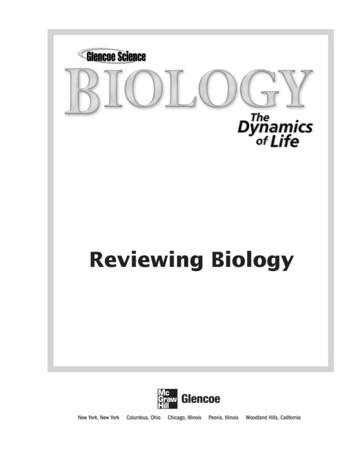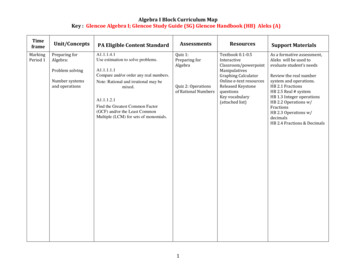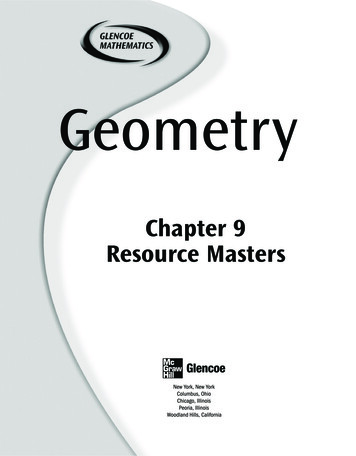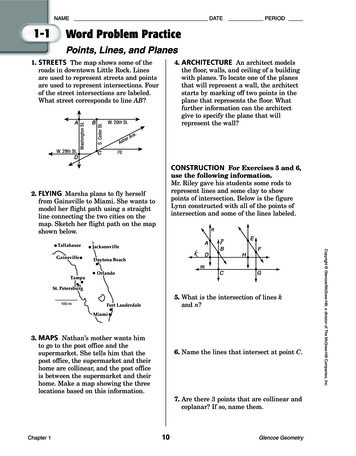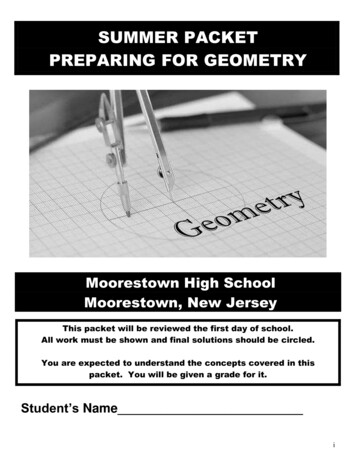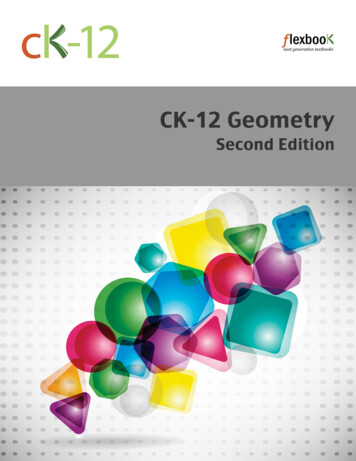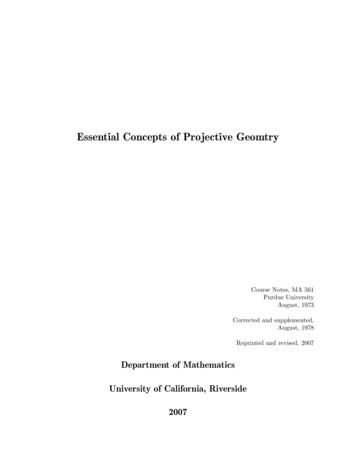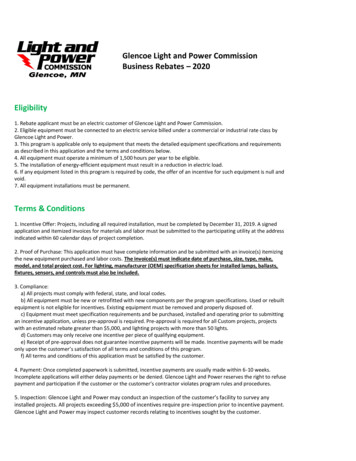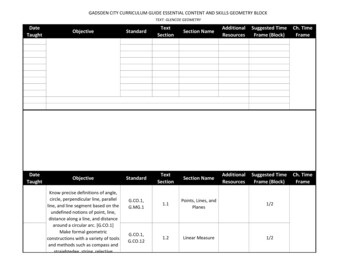
Transcription
GADSDEN CITY CURRICULUM GUIDE ESSENTIAL CONTENT AND SKILLS GEOMETRY BLOCKTEXT: GLENCOE ion NameAdditionalResourcesSuggested TimeFrame (Block)Ch. tion NameAdditionalResourcesSuggested TimeFrame (Block)Ch. TimeFrameG.CO.1,G.MG.11.1Points, Lines, andPlanes1/2G.CO.1,G.CO.121.2Linear Measure1/2Know precise definitions of angle,circle, perpendicular line, parallelline, and line segment based on theundefined notions of point, line,distance along a line, and distancearound a circular arc. [G.CO.1]Make formal geometricconstructions with a variety of toolsand methods such as compass andstraightedge, string, relectivedevices, paper folding, and dynamicgeometric software. Constructionsinclude copying a segment; copying
Make formal geometricconstructions with a variety of toolsGADSDEN CITY CURRICULUM GUIDE ESSENTIAL CONTENT AND SKILLS GEOMETRY BLOCKand methods such as compass andTEXT: GLENCOE GEOMETRYstraightedge, string, relectivedevices, paper folding, and dynamicG.CO.1,Distance andgeometric software. Constructions1.31/2G.CO.12Midpointsinclude copying a segment; copyingan angle; bisecting a segment;bisecting an angle; constructionG.CO.1,perpendicular lines, including1.4Angle Measure1/2G.CO.12perpendicular bisector of a linesegment; and constructing a lineparallel to a given line through aAngleG.CO.121.51 daypoint not on the line. [G.CO.12]RelationshipsUse Geometric shapes, theirmeasures, and their properties toG.GPE.7,Two-Dimensionaldescribe objects. [G.MG.1]Use1.61 dayG.CO.12Figurescoordinates to compute perimeters6 Daysof polygons and areas of trianglesand rectangles using the distanceformula. [G.GPE.7] Use volumeformulas for cylinders, pyramids,cones, and spheres to solveproplems. [G.GMD.3]DateTaughtObjectiveReview Ch. 11 dayTest Ch. 11StandardTextSection2.12.32.4Section NameInductivereasoning alResourcesSuggested TimeFrame (Block)1/2 day1/2 day1/2 dayCh. TimeFrame
GADSDEN CITY CURRICULUM GUIDE ESSENTIAL CONTENT AND SKILLS GEOMETRY BLOCKTEXT: GLENCOE GEOMETRYG.MG.3Apply geometric methods to solvedesignproblem. [G.MG.3] Provetheorems about lines and angles.Theorems include vertical anglesare congruent; when a transversalcrosses parallel lines, alternateinterior angles are congruent andcorrresponding angles arecongruent; and points on aperpendicular bisector of a linesegment are exactly thoseequidistant from the segment'sendpoints. [G.CO.9] Make formalgeometric constructions with avariety of tools and methods suchas compass and straightedge,string, relective devices, paperfolding, and dynamic geometricsoftware. Constructions includecopying a segment; copying anangle; bisecting a segment;bisecting an angle; constructionperpendicular lines, includingperpendicular bisector of a linesegment; and constructing a lineparallel to a given line through apoint not on the line. [G.CO.12]2.5Postulates andParagraph Proofs1/22.6Algebraic Proof1/2 day5 DaysG.CO.9,G.CO.122.7Proving SegmentRelationships1/2
copying a segment; copying anangle; bisecting a segment;CITY CURRICULUM GUIDE ESSENTIAL CONTENT AND SKILLS GEOMETRY BLOCKbisecting an angle;GADSDENconstructionTEXT: GLENCOE GEOMETRYperpendicular lines, includingperpendicular bisector of a linesegment; and constructing a lineparallel to a given line through apoint not on the line. [G.CO.12]G.CO.9DateTaughtObjectiveKnow precise definitions of angle,circle, perpendicular line, parallel line,and line segment based on theundefined notions of point, line,distance along a line, and distancearound a circular arc. [G.CO.1] Makeformal geometric constructions with avariety of tools and methods such ascompass and straightedge, string,relective devices, paper folding, anddynamic geometric software.Constructions include copying asegment; copying an angle; bisecting asegment; bisecting an angle;construction perpendicular lines,including perpendicular bisector of aline segment; and constructing a lineparallel to a given line through a pointnot on the line. [G.CO.12] Provetheorems about lines and angles.Theorems include vertical angles arecongruent; when a transversal crossesparallel lines, alternate interior angles2.8Proving AngleRelationships1/2Review Ch. 21/2Test Ch. 21StandardTextSectionSection NameAdditionalResourcesSuggested TimeFrame (Block)G.CO.1,G.CO.123.1Parallel Lines andTransversals1/2G.CO.1,G.CO.93.2Angles andParallel Lines1/2G.GPE.53.3Slopes of Lines1 dayG.GPE.53.4Equations of Lines1dayCh. TimeFrame6 Days
line segment; and constructing a lineparallel to a given line through a pointnot on the line. [G.CO.12]ProveGADSDENCITY CURRICULUM GUIDE ESSENTIAL CONTENT AND SKILLS GEOMETRY BLOCKtheorems about lines and angles.TEXT: GLENCOE GEOMETRYTheorems include vertical angles arecongruent; when a transversal crossesparallel lines, alternate interior anglesG.CO.9,Proving Linesare congruent and corrresponding3.51 dayG.CO.12Parallelangles are congruent; and points on aperpendicular bisector of a linesegment are exactly those equidistantfrom the segment's endpoints. [G.CO.9]Prove the slope criteria for parallel andperpendicular lines, and use them toG.CO.12,Perpendiculars3.61/2solve geometric problems. [G.GPE.5]G.MG.3and DistanceApply geometric methods to solvedesign propelems. [G.MG.3]DateTaughtObjectiveMake formal geometric constructions with avariety of tools and methods such as compassand straightedge, string, relective devices, paperfolding, and dynamic geometric software.Constructions include copying a segment; copyingan angle; bisecting a segment; bisecting an angle;construction perpendicular lines, includingperpendicular bisector of a line segment; andconstructing a line parallel to a given line througha point not on the line. [G.CO.12] Provetheorems about triangles. Theorems includemeasure of interior angles of a triangle sum to180, base angles of isosceles triangles arecongruent, the segment joining midpoints of twosides of a triangle is parallel to the third side andhalf the length, and the medians of a trianglemeet at a point. [G.CO.10] Use the definition ofcongruence in terms of rigid motions to showthat two triangles are congruent if and only ifcorresponding pairs of sides and correspondingpairs of angles are congruent. [G.CO.7] Usecongruence and similarity criteria for triangles tosolve problems and to prove relationships inReview Ch. 31/2Test Ch. 31StandardTextSectionSection les of 4.4Proving 12AdditionalResourcesSuggested TimeFrame (Block)6 DaysCh. TimeFrame6 Days
theorems about triangles. Theorems includemeasure of interior angles of a triangle sum to180, base angles of isoscelestriangles areGADSDENCITY CURRICULUMcongruent, the segment joining midpoints of twosides of a triangle is parallel to the third side andhalf the length, and the medians of a trianglemeet at a point. [G.CO.10] Use the definition ofcongruence in terms of rigid motions to showG.CO.10,that two triangles are congruent if and only ifcorresponding pairs of sides and correspondingG.SRT.5pairs of angles are congruent. [G.CO.7] Usecongruence and similarity criteria for triangles tosolve problems and to prove relationships ingeometric figures. [G.SRT.5] Given a geometricfigure and a rotation, reflection, or translation,G.CO.10,draw the transformed figure using graph paper,G.CO.12tracing paper, or geometry software. Specify asequence of transformation that will carry a givenfigure onto another. [G.CO.5] Use geometricdescriptions of rigid motions to transform figuresand to predict the effect of a given rigid motionon a given figure; given two figure, use thedefinition of congruence in terms of rigid motionsto decide if they are congruent. [G.CO.6] Usecoordinates to prove simple geometric theoremsalgebraically. [G.GPE.4]GUIDE ESSENTIAL CONTENT AND SKILLS GEOMETRY BLOCKTEXT: GLENCOE GEOMETRYG.CO.10,G.GPE.44.5Proving TrianglesCongruent-ASA,AAS1/24.6Isosceles andEquilateralTriangles1/24.8Triangles andCoordinate Proof1 dayReview Ch. 4Test Ch. 4DateTaught1 day1ObjectiveStandardTextSectionSection NameMake formal geometricconstructions with a variety of toolsand methods such as compass andstraightedge, string, relectivedevices, paper folding, and dynamicgeometric software. Constructionsinclude copying a segment; copyingan angle; bisecting a segment;bisecting an angle; constructionperpendicular lines, includingperpendicular bisector of a linesegment; and constructing a lineparallel to a given line through apoint not on the line. [G.CO.12]G.CO.12,G.CO.10,G.MG.35.1Bisectors ofTriangles1 day5.2Medians andAltitudes ofTriangles1 dayG.CO.12,G.CO.10,G.MG.36 DaysAdditionalResourcesSuggested TimeFrame (Block)Ch. TimeFrame
geometric software. Constructionsinclude copying a segment; copyingCITY CURRICULUM GUIDE ESSENTIAL CONTENT AND SKILLS GEOMETRY BLOCKan angle; bisectingGADSDENa segment;bisecting an angle; constructionperpendicular lines, includingperpendicular bisector of a linesegment; and constructing a lineparallel to a given line through apoint not on the line. [G.CO.12]Prove theorems about triangles.Theorems include measure ofinterior angles of a triangle sum to180, base angles of isoscelestriangles are congruent, thesegment joining midpoints of twosides of a triangle is parallel to thethird side and half the length, andthe medians of a triangle meet at apoint. [G.CO.10] Apply geometricmethods to solve designpropelems. [G.MG.3]DateTaughtObjectiveUse Geometric shapes, theirmeasures, and their properties todescribe objects. [G.MG.1] Provetheorems about parallelograms.Theorems include opposite sidesare congruent, opposite angles andcongruent; the diagonals of aparallelogram bisect each other;and conversely, rectangles areparallelograms with congruentdiagonals. [G.CO.11] Make formalgeometric constructions with avariety of tools and methods suchTEXT: GLENCOE GEOMETRYG.CO.105.3Inequalities in OneTriangle1/27 DaysG.CO.105.4Indirect Proof1/2G.CO.12,G.CO.10,G.MG.35.5The TriangleInequality1 dayG.CO.105.6Inequalities inTwo Triangles1 dayReview Ch. 51 dayTest Ch. 51StandardTextSectionSection NameG.MG.16.1Angles of PolygonsAdditionalResourcesSuggested TimeFrame (Block)1 dayCh. TimeFrame
theorems about parallelograms.Theorems include oppositesidesGADSDENCITY CURRICULUM GUIDE ESSENTIAL CONTENT AND SKILLS GEOMETRY BLOCKare congruent, opposite angles andTEXT: GLENCOE GEOMETRYcongruent; the diagonals of aparallelogram bisect each other;and conversely, rectangles areG.CO.11,parallelograms with congruentG.GPE.4,6.2Parallelograms1/2diagonals. [G.CO.11] Make formalG.CO.12geometric constructions with avariety of tools and methods suchas compass and straightedge,string, relective devices, paperG.CO.11,Tests for6.31/2folding, and dynamic geometricG.GPE.4Parallelogramssoftware. Constructions includecopying a segment; copying anangle; bisecting a segment;G.CO.11,bisecting an angle; construction6.4Rectangles1/2G.GPE.4perpendicular lines, includingperpendicular bisector of a linesegment; and constructing a lineparallel to a given line through apoint not on the line. [G.CO.12] Usecoordinates to prove simplegeometric theorems algebraically.[G.GPE.4] Apply geometricmethods to solve design problems.[G.MG.3]DateTaughtObjectiveApply geometric methods to solvedesign problems (designing an object orstructure to satisfy physical constraintsor minimize cost, working withtypographic grid systems based onratios)* [G.MG.3] Given two figures,G.CO.11,G.GPE.46.5Rhombi andSquares1/2G.GPE.4,G.MG.36.6Trapezoids andKites1 dayReview Ch. 61 dayTest Ch. 61StandardTextSectionSection NameG.MG.37.1Ratios andProportionsAdditionalResourcesSuggested TimeFrame (Block)1/26 DaysCh. TimeFrame
GADSDENCITY CURRICULUM GUIDE ESSENTIAL CONTENT AND SKILLS GEOMETRY BLOCKApply geometric methodsto solvedesign problems (designing an object orTEXT: GLENCOE GEOMETRYstructure to satisfy physical constraintsor minimize cost, working withtypographic grid systems based onG.SRT.27.2Similar Polygons1/2ratios)* [G.MG.3] Given two figures,use the definition of similarity in termsof similarity transformations to decideG.SRT.4,if they are similar; explain usingG.SRT.5,7.3Similar Triangles1 daysimilarity transformations the meaningG.GPE.5of similarity for triangles as the equalityof all corresponding angles and theproportionality of all correspondingG.SRT.4,Parallel Lines andpairs of sides. [G.SRT.2] Prove the7.41/2G.SRT.5ProportionalPartstheorems about triangles. Theoremsinclude a line parallel to one side of atriangle divides the other twoproportionally, and conversely; and theG.SRT.4,Parts of SimilarPythagorean Theorem proved using7.51/2G.SRT.5Trianglestriangle similarity. [G.SRT.4] Usecongruence and similarity criteria fortriangles to solve problems and toprove relationships in geometricfigures. [G.SRT.5] Prove the slopecriteria for parallel and perpendicularlines, and use them to solve geometricproblems (find the equation of a linepareallel or perpendicular to a givenline that passes through a given point).Scale Drawings[G.GPE.5]G.MG.37.71 day6 Daysand ModelsReview Ch. 7Test Ch. 7DateTaughtObjectiveStandard11TextSectionSection Name0.9Simplfying squareroots & radicalsAdditionalResourcesSuggested TimeFrame (Block)1/2 dayCh. TimeFrame
GADSDEN CITY CURRICULUM GUIDE ESSENTIAL CONTENT AND SKILLS GEOMETRY BLOCKTEXT: GLENCOE GEOMETRYProve the theorems about triangles. Theoremsinclude a line parallel to one side of a triangledivides the other two proportionally, andconversely; and the Pythagorean Theoremproved using triangle similarity. [G.SRT.4] Usecongruence and similarity criteria for triangles tosolve problems and to prove relationships ingeometric figures. [G.SRT.5] Prove theoremsabout triangles. Theorems include measures ofinterior angles of a triangle sum is 180, baseangles of isosceles triangles are congruent, thesegment joining midpoints of two sides of atriangle is parallel to the third side and half thelength, and the medians of a triangle meet at apoint. [G.CO.10] Use trigonometric ratios and thePythagorean Theorem to solve right triangles inapplied problems.* [G.SRT.8] Apply geometricmethods to solve design problems (designing anobject or structure to satisfy physical constraintsor minimize cost, working with typographic gridsystems based on ratios)* [G.MG.3] Understandthat by similarity, side ratios in right triangles areproperties of the angles in the triangle leading todefinitions of trigonometric ratios for acuteangles. [G.SRT.6] Explain and use the relationshipbetweeen the sine and cosine of complementaryangles. [G.SRT.7] Derive the formula A 1/2 absin(C) for the area of a triangle by drawing anauxiliary line from a vertex perpendicular to theopposite side. [G.SRT.9] Prove the Law of Sinesand the Law of Cosines and use them to solveproblems. [G.SRT.10] Understand and apply theLaw of Sines and the Law of Cosines to findunknown measurements in right and non-righttriangles (surveying problems, resultant forces).[G.SRT.11] Find the point on a directed linesegment between two given points thatpartitions the segment in a given ratio. [G.GPE.6]G.SRT.4,G.SRT.5,G.CO.108.1Geometric Mean1 dayG.SRT.8,G.MG.38.2The PythagoreanTheorem and ItsConverse1/2 dayG.SRT.68.3Special RightTriangles2 daysG.SRT.6,G.SRT.78.4Trigonometry3 daysG.SRT.88.5Angles ofElevation andDepression1 dayG.SRT.9,G.SRT.10,G.SRT.118.6The Law of Sinesand Law ofCosines2 daysG.GPE.68.7Vectors1 day12 DaysReview Ch. 8Test Ch. 8DateTaughtObjectiveStandardTextSection11Section NameAdditionalResourcesSuggested TimeFrame (Block)Ch. TimeFrame
GADSDEN CITY CURRICULUM GUIDE ESSENTIAL CONTENT AND SKILLS GEOMETRY BLOCKTEXT: GLENCOE GEOMETRYDevelop definitions of rotations, refections, andtranslations in terms of angles, circles,perpendicular lines, parallel lines, and linesegments. [G.CO.4] Given a geometric figure anda rotation, reflection, or translation, draw thetransformed figure using graph paper, tracingpaper, or geometry software. Specify a sequenceof transformations that will carry a given figureonto another. [G.CO.5] Representtransformations in the plane using transparenciesand geometry software; describe transformationsas functions that take points in the plane asinputs and give other points as outputs. Comparetransformations that preserve distance and angleto those that do not (translation versus horizontalstretch) Identify the shapes of two-dimensionalcross-sections of three dimensional objects, andidentify three-dimensional objects generated byrotations of two-dimensional objects. [G.GMD.4]Given a rectangle, parallelogram, trapezoid, orregular polygon, describe the rotations andreflections that carry it onto itself. [G.CO.3] Makeformal geometric constructions with a variety oftools and methods such as compass andstraightedge, string, reflective devices, paperfolding, and dynamic geometric software.Constructions include copying a segment; copyingan angle; bisecting a segment; bisecting an angle;constructing perpendicular lines, including theperpendicular bisector of a line segment; andconstructing a line parallel to a given line througha point not on the line. [G.CO.12] Verifyexperimentally the properties of dilations givenby a center and a scale factor. [G.SRT.1] Explainhow the criteria for triangle congruence, angleside-angle (ASA), side-angle-side (SAS), and sideside-side (SSS), follow from the definition ofcongruence in terms of rigid motions. [G.CO.8]Use the properties of similarity transformationsto establish the angle-angle (AA) criterion for twotringles to be similar. [G.SRT.3]4.7Congruencetransformation1/2 ions1/2G.CO.2,G.CO.59.4Compositions SRT.1,G.CO.2,G.CO.8,G.SRT.39.6Dilations1/2Review Ch. 91 day6 Days
GADSDEN CITY CURRICULUM GUIDE ESSENTIAL CONTENT AND SKILLS GEOMETRY BLOCKTEXT: GLENCOE GEOMETRYTest Ch. 9DateTaughtObjectiveKnow precise definitions of angle, circle,perpendicular line, parallel line, and line segmentbased on the undefined notions of point, line,distance along a line, and distance around a circulararc. [G.CO.1] Prove that all circles are similar. [G.C.1]Identify and describe relationships among inscribedangles, radii, and chords. Include the relationshipbetween central, inscribed, and circumscribedangles; inscribed angles on a diameter are rightangles; the radius of a circle is perpendicular to thetangent where the radius intersects the circle.[G.C.2] Derive, using similarity, the fact that thelength of the arc intercepted by an angle isproportional to the radius, and define the radianmeasure of the angle as the constant ofproportionality; derive the formula for the area of asector. [G.C.5] Apply geometric methods to solvedesign problems (designing an object or structure tosatisfy physical constraints or minimize cost, workingwith typographic grid systems based on ratios)*[G.MG.3] Construct the inscribed and circumscribedcircles of a triangle, and prove properties of anglesfor a quadrilateral inscribed in a circle. [G.C.3] Makeformal geometric constructions with a variety oftools and methods such as compass andstraightedge, string, reflective devices, paper folding,and dynamic geometric software. Constructionsinclude copying a segment; copying an angle;bisecting a segment; bisecting an angle; constructingperpendicular lines, including the perpendicularbisector of a line segment; and constructing a lineparallel to a given line through a point not on theline. [G.CO.12] Construct a tangent line from a pointoutside a given circle to the circle. [C.C.4] Constructan equilateral triangle, a square, and a regularhexagon inscribed in a circle. [G.CO.13] Derive theequation of a circle of given center and radius usingthe Pythagorean Theorem; complete the square tofind the center and radius of a circle given by anequation. [G.GPE.1] Find the point on a directed line1StandardTextSectionSection NameAdditionalResourcesSuggested TimeFrame (Block)G.CO.1, G.C.110.1Circles andCircumference1/2G.C.2, G.C.510.2Measuring Anglesand Arcs1/2G.C.2, G.MG.310.3Arcs and Chords1/2G.C.2, G.C.310.4Inscribed Angles1/2Ch. TimeFrame6 DaysG.CO.12,G.C.4,G.CO.13, G.C.310.5Tangents1/2
straightedge, string, reflective devices, paper folding,and dynamic geometric software. Constructionsinclude copying a segment; copying an angle;CITY CURRICULUMbisecting a segment; bisecting GADSDENan angle; constructingperpendicular lines, including the perpendicularbisector of a line segment; and constructing a lineparallel to a given line through a point not on theline. [G.CO.12] Construct a tangent line from a pointoutside a given circle to the circle. [C.C.4] Constructan equilateral triangle, a square, and a regularhexagon inscribed in a circle. [G.CO.13] Derive theequation of a circle of given center and radius usingthe Pythagorean Theorem; complete the square tofind the center and radius of a circle given by anequation. [G.GPE.1] Find the point on a directed linesegment between two given points that partitionsthe segment in a given ratio. [G.GPE.6]G.GPE.1,G.GPE.6,G.GPE.2GUIDE ESSENTIAL CONTENT AND SKILLS GEOMETRY BLOCKTEXT: GLENCOE GEOMETRY10.6Secants, tangents,& angle measures1/210.7Special segmentsin a circle1/210.8Equations ofCircles1/2Review Ch. 10Test Ch. 10DateTaughtObjectiveUse coordinates to compute perimeters ofpolygons and areas of triangles andrectangles, using the distance formula.*[G.GPE.7] Apply geometric methods to solvedesign problems (designing an object orstructure to satisfy physical constraints orminimize cost, working with typographicgrid systems based on ratios)* [G.MG.3]Apply concepts of density based on areaand volume in modeling situations (personsper square mile, British Thermal Units percubic foot)* [G.MG.2] Derive, usingsimilarity, the fact that the length of the arcintercepted by an angle is proportional tothe radius, and define the radian measureof the angle as the constant ofproportionality; derive the formula for thearea of a sector. [G.C.5] Give an nSection NameAdditionalResourcesSuggested TimeFrame (Block)1.62-D figures1/211.1Areas ofParallelogramsand Triangles1/211.2Areas ofTrapezoids,Rhombi, and Kites1/2Ch. TimeFrame5 Days
per square mile, British Thermal Units percubic foot)* [G.MG.2] Derive, usingsimilarity, the fact that thelength of thearc CURRICULUM GUIDE ESSENTIAL CONTENT AND SKILLS GEOMETRY BLOCKGADSDENCITYintercepted by an angle is proportional toTEXT: GLENCOE GEOMETRYthe radius, and define the radian measureof the angle as the constant ofproportionality; derive the formula for theG.C.5,Areas of Circlesarea of a sector. [G.C.5] Give an informal11.31/2aguement for the formulas for theG.GMD.1and Sectorscircumference of a circle; area of a circle;and volume of a cylinder, pyramid, andcone. Use dissection agruements,Cavalieri's principle, and informal limitarguments. [G.GMD.1] Use geometricAreas of Regularshapes, their measures, and their propertiesG.MG.311.4Polygons and1to describe objects (modeling a tree trunkor a human torso as a cylinder)* [G.MG.1]Composite FiguresDetermine areas and perimeters of regularpolygons, including inscribed orcircumscribed polygons, given thecoordinates of verticees or othercharacteristics. [AL]G.MG.111.5Areas of SimilarFigures1/2Review Ch. 11Test Ch. 11DateTaughtObjectiveIdentify the shapes of twodimensional cross-sections of threedimensional objects, and identifythree-dimensional objectsgenerated by rotations of twodimensional objects. [G.GMD.4]Apply geometric methods to solvedesign problems (designing anobject or structure to satisfyphysical constraints or minimizecost, working with typographic gridsystems based on ratios)* [G.MG.3]Use geometric shapes, theirmeasures, and their properties todescribe objects (modeling a treetrunk or a human torso as a5 Days1/21StandardTextSectionSection NameAdditionalResourcesSuggested TimeFrame (Block)G.GMD.41.73-D figures1/3G.MG.312.2Surface Areas ofPrisms andCylinders1/3Ch. TimeFrame
Apply geometric methods to solvedesign problems (designing anobject or structureto satisfyCITY CURRICULUM GUIDE ESSENTIAL CONTENT AND SKILLS GEOMETRY BLOCKGADSDENphysical constraints or minimizeTEXT: GLENCOE GEOMETRYcost, working with typographic gridsystems based on ratios)* [G.MG.3]Surface Areas ofUse geometric shapes, theirG.MG.112.3Pyramids and1/3measures, and their properties toConesdescribe objects (modeling a treetrunk or a human torso as acyliner)* [G.MG.1] Give an informalargument for the formulas for theG.GMD.1,Volumes of Prisms12.41/2circumference of a circle; area of aG.GMD.3and Cylinderscircle; and volume of a cylinder,pyramid, and cone. Use dissectionarguments, Cavalieri's principle,and informal limit arguments.Volumes ofG.GMD.1,[G.GMD.1] Use volume formulas12.5Pyramids and1/2G.GMD.3for cylinders, pyramids, cones, andConesspheres to solve problems.*[G.GMD.3] Determine theSurface Areas andrelationship between surface areasG.GMD.1,12.6Volumes of1/2of similar figures and volumes ofG.GMD.3Spheressimilar figures. [AL]12.8DateTaughtObjectiveUse permutations and combinations to compute probabilities ofcompound events and solve problems. [S.CP.9] Analyze decisionsand strategies using probability concepts (product testing, medicaltesting, pulling a hockey goalie at the end of a game). [S.MD.7]Apply geometric methods to solve design problems (designing anobject or structure to satisfy physical constraints or minimize cost,working with typographic grid systems based on ratios)* [G.MG.3]Use probabilities to make fair decisions (drawing by lots, using arandom number generator). [S.MD.6] Understand that two eventsA and B are independent if the probability of A and B occurringtogether is the product of their probabilities, and use thischaracterization to determine if they are independent. [S.CP.2]Understand the conditional probability of A given B as P(A andB)/P(B), and interpret independence of A and B as saying that theCongruent &similar solids1/2Review Ch. 121Test Ch. 121StandardTextSectionSection NameS.CP.90.3Simple Probability5 DaysAdditionalResourcesSuggested TimeFrame (Block)1/2Ch. TimeFrame
compound events and solve problems. [S.CP.9] Analyze decisionsand strategies using probability concepts (product testing, medicaltesting, pulling a hockey goalie at the end of a game). [S.MD.7]Apply geometric methods to solve design problems (designing anobject or structure to satisfy physical constraints or minimize cost,working with typographic grid systems based on ratios)* [G.MG.3]Use probabilities to make fair decisions (drawing by lots, using arandom number generator). [S.MD.6] Understand that two eventsA and B are independent if the probability of A and B occurringtogether is the product of their probabilities, and use thischaracterization to determine if they are independent. [S.CP.2]Understand the conditional probability of A given B as P(A andB)/P(B), and interpret independence of A and B as saying that theconditional probability of A given B is the same as the probabilityof A, and the conditional probability of B given A is the same as theprobability of B. [S.CP.3] Construct and interpret two-wayfrequency tables of data when two categories are associated witheach object being classified. Use the two-way table as a samplespace to decide if events are independent and to approximateconditional probabilities. Collect data from a random sample ofstudents in your school on their favorite subject amongmathematics, science, and English. Estimate the probability that arandomly selected student from your school will favor sciencegiven that the student is in tenth grade. Do the same for othersubjects and compare the results. [S.CP.4] Find the conditionalprobability of A given B as the fraction of B's outcomes that alsobelong to A, and interpret the answer in terms of the model.[S.CP.6] Describe events as subsets of a sample space (the set ofoutcomes), using characteristics (or categories) of the outcomes,or as unions, intersections, or complements of other events ("or","and", or "not") [S.CP.1] Apply the Addition Rule, P(A orB) P(A) P(B)-P(A and B), and interpret the anser in terms of themodel. [S.CP.7] Recognize and explain the concepts of conditionalprobability and independence in everyday language and everydaysituations. Compare the chance of having lung cancer if you are asmoker with the chance of being a smoker if you have long cancer.[S.CP.5] Apply ther general Multiplication Rule in a uniformprobability model,P(A andB) P(A)P(B/A) P(B)P(A/B), and interpret the answer in terms ofthe model. [S.CP.8] Use permutations and combinations tocompute probabilites of compound events and solve problems.[S.CP.9] Analyze decisions and strategies using probabilityconcepts (product testing, medical testing, pulling a hockey goalieat the end of a game) [S.MD.7]GADSDEN CITY CURRICULUM GUIDE ESSENTIAL CONTENT AND SKILLS GEOMETRY BLOCKTEXT: GLENCOE MD.613.4Simulations1/23 DaysReview Ch. 13Test Ch. 13Review Semester ExamTest Semester Exam1/21213 Days
GADSDEN CITY CURRICULUM GUIDE ESSENTIAL CONTENT AND SKILLS GEOMETRY BLOCKTEXT: GLENCOE GEOMETRY
GADSDEN CITY CURRICULUM GUIDE ESSENTIAL CONTENT AND SKILLS GEOMETRY BLOCKTEXT: GLENCOE GEOMETRY
GADSDEN CITY CURRICULUM GUIDE ESSENTIAL CONTENT AND SKILLS GEOMETRY BLOCKTEXT: GLENCOE GEOMETRY
GADSDEN CITY CURRICULUM GUIDE ESSENTIAL CONTENT AND SKILLS GEOMETRY BLOCKTEXT: GLENCOE GEOMETRY
GADSDEN CITY CURRICULUM GUIDE ESSENTIAL CONTENT AND SKILLS GEOMETRY BLOCKTEXT: GLENCOE GEOMETRY
GADSDEN CITY CURRICULUM GUIDE ESSENTIAL CONTENT AND SKILLS GEOMETRY BLOCKTEXT: GLENCOE GEOMETRY
GADSDEN CITY CURRICULUM GUIDE ESSENTIAL CONTENT AND SKIL
TEXT: GLENCOE GEOMETRY G.CO.10, G.SRT.5 4.5 Proving Triangles Congruent-ASA, AAS 1/2 G.CO.10, G.CO.12 4.6 Isosceles and Equilateral Triangles 1/2 G.CO.10, G.GPE.4 4.8 Triangles and Coordinate Proof 1 day 1 day 1 Date Taught Objective Standard Text Section Section Name Additio

